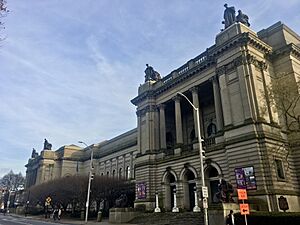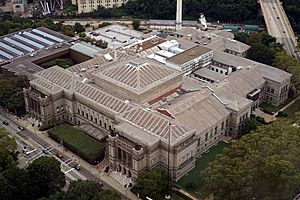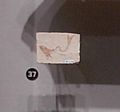Carnegie Museum of Natural History facts for kids

One of the four Carnegie Museums of Pittsburgh
|
|
| Lua error in Module:Location_map at line 420: attempt to index field 'wikibase' (a nil value). | |
| Established | 1895 |
|---|---|
| Location | Pittsburgh, Pennsylvania |
| Type | Natural History |
| Visitors | 300,000 |
| Public transit access | 54, 58, 61A, 61B, 61C, 61D, 67, 69 |
| Nearest parking | On site and street |
The Carnegie Museum of Natural History, often called CMNH, is a super cool museum in Pittsburgh, Pennsylvania. It's all about natural history! A famous businessman named Andrew Carnegie started it way back in 1896.
This museum is home to about 22 million items. It has some of the biggest collections of paleontology (that's the study of fossils) and entomology (the study of insects) in the whole world!

Contents
Exploring the Museum
The Carnegie Museum of Natural History is a huge place. It has 20 different rooms, called galleries, where you can see amazing things. There are also spaces for research, a library, and offices.
Out of 22 million items, about 10,000 are on display at any time. Imagine how many cool things are waiting to be seen! In 2008, over 386,000 people visited the museum. Plus, 63,000 students came on school trips. The museum also sends its teachers to schools all over western Pennsylvania.
Dinosaur Discoveries
The museum became very famous in 1899. That's when its scientists found the fossils of a dinosaur called Diplodocus carnegii. This dinosaur was even named after Andrew Carnegie!
The museum has some truly special dinosaur fossils. You can see one of the only known fossils of a young Apatosaurus. They also have the world's first ever fossil of a Tyrannosaurus rex. That's right, the first T-Rex fossil ever found is here! Another cool find is a new type of dinosaur called Anzu wyliei.
Scientists connected to the Carnegie Museum have made other important discoveries too. These include ancient animals like Puijila darwini, Castorocauda lutrasimilis, and Hadrocodium wui.
Cool Exhibits to See
Besides the dinosaurs, there are many other exciting exhibits. You can visit the Hillman Hall of Minerals and Gems to see sparkling rocks. The Alcoa Foundation Hall of American Indians teaches about Native American cultures.
In Polar World: Wyckoff Hall of Arctic Life, you can learn about animals that live in cold places. The Walton Hall of Ancient Egypt has real mummies! Benedum Hall of Geology shows how our Earth was formed. And "Dinosaurs in Their Time" lets you see dinosaurs as they might have lived.
The museum also runs the Powdermill Nature Reserve. This is a special outdoor place. It was started in 1956 for scientists to study animals and plants in nature.
What Scientists Study Here
The museum has many different science departments. These include:
- Anthropology (the study of people and cultures)
- Birds
- Botany (the study of plants)
- Herpetology (the study of Amphibians and Reptiles)
- Mammals
- Minerals
- Mollusks (like snails and clams)
- Vertebrate Paleontology (the study of ancient animals with backbones)
These teams work together to learn more about our world. They also help create the exhibits you see.
Museum Publications
The Carnegie Museum of Natural History also publishes books and journals. These are for scientists and researchers. Annals of Carnegie Museum has articles about animals, plants, Earth science, and people. Other publications share big research projects or special topics.
More to Explore
- Carnegie Museums of Pittsburgh
- Carnegie Collection
- List of museums in Pennsylvania
- Andrew Carnegie
See also
 In Spanish: Museo Carnegie de Historia Natural para niños
In Spanish: Museo Carnegie de Historia Natural para niños






